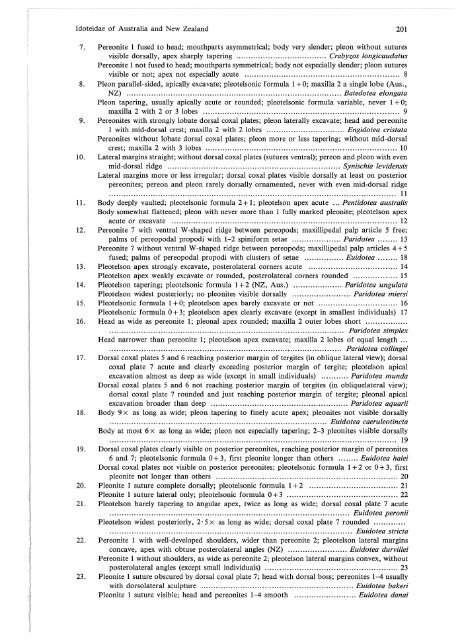Idoteidae of Australia and New Zealand (Crustacea: Isopoda: Valvif ...
Idoteidae of Australia and New Zealand (Crustacea: Isopoda: Valvif ...
Idoteidae of Australia and New Zealand (Crustacea: Isopoda: Valvif ...
You also want an ePaper? Increase the reach of your titles
YUMPU automatically turns print PDFs into web optimized ePapers that Google loves.
<strong>Idoteidae</strong> <strong>of</strong> <strong>Australia</strong> <strong>and</strong> <strong>New</strong> Zeal<strong>and</strong> 201<br />
7. Pereonite 1 fused to head; mouthparts asymmetrical; body very slender; pleon without sutures<br />
visible dor sally, apex sharply tapering Crabyzos longicaudatus<br />
Pereonite 1 not fused to head; mouthparts symmetrical; body not especially slender; pleon sutures<br />
visible or not; apex not especially acute 8<br />
8. Pleon parallel-sided, apically excavate; pleotelsonic formula 1+0; maxilla 2 a single lobe (Aus.,<br />
NZ) Batedotea elongata<br />
Pleon tapering, usually apically acute or rounded; pleotelsonic formula variable, never 1+0;<br />
maxilla 2 with 2 or 3 lobes 9<br />
9. Pereonites with strongly lobate dorsal coxal plates; pleon laterally excavate; head <strong>and</strong> pereonite<br />
1 with mid-dorsal crest; maxilla 2 with 2 lobes Engidolea cristata<br />
Pereonites without lobate dorsal coxal plates; pleon more or less tapering; without mid-dorsal<br />
crest; maxilla 2 with 3 lobes 10<br />
10. Lateral margins straight; without dorsal coxal plates (sutures ventral); pereon <strong>and</strong> pleon with even<br />
mid-dorsal ridge Synischia levidensis<br />
Lateral margins more or less irregular; dorsal coxal plates visible dorsally at least on posterior<br />
pereonites; pereon <strong>and</strong> pleon rarely dorsally ornamented, never with even mid-dorsal ridge<br />
11<br />
11. Body deeply vaulted; pleotelsonic formula 2+1; pleotelson apex acute ... Pentidotea australis<br />
Body somewhat flattened; pleon with never more than 1 fully marked pleonite; pleotelson apex<br />
acute or excavate 12<br />
12. Pereonite 7 with ventral W-shaped ridge between pereopods; maxillipedal palp article 5 free;<br />
palms <strong>of</strong> pereopodal propodi with 1-2 spiniform setae Paridotea 13<br />
Pereonite 7 without ventral W-shaped ridge between pereopods; maxillipedal palp articles 4 + 5<br />
fused; palms <strong>of</strong> pereopodal propodi with clusters <strong>of</strong> setae Euidotea 18<br />
13. Pleotelson apex strongly excavate, posterolateral corners acute 14<br />
Pleotelson apex weakly excavate or rounded, posterolateral corners rounded 15<br />
14. Pleotelson tapering; pleotelsonic formula 1+2 (NZ, Aus.) Paridotea ungulata<br />
Pleotelson widest posteriorly; no pleonites visible dorsally Paridotea miersi<br />
15. Pleotelsonic formula 1+0; pleotelson apex barely excavate or not 16<br />
Pleotelsonic formula 0 + 3; pleotelson apex clearly excavate (except in smallest individuals) 17<br />
16. Head as wide as pereonite 1; pleonal apex rounded; maxilla 2 outer lobes short<br />
Paridotea simplex<br />
Head narrower than pereonite 1; pleotelson apex excavate; maxilla 2 lobes <strong>of</strong> equal length ...<br />
Paridotea collingei<br />
17. Dorsal coxal plates 5 <strong>and</strong> 6 reaching posterior margin <strong>of</strong> tergites (in oblique lateral view); dorsal<br />
coxal plate 7 acute <strong>and</strong> clearly exceeding posterior margin <strong>of</strong> tergite; pleotelson apical<br />
excavation almost as deep as wide (except in small individuals) Paridotea munda<br />
Dorsal coxal plates 5 <strong>and</strong> 6 not reaching posterior margin <strong>of</strong> tergites (in obliquelateral view);<br />
dorsal coxal plate 7 rounded <strong>and</strong> just reaching posterior margin <strong>of</strong> tergite; pleonal apical<br />
excavation broader than deep Paridotea aquarii<br />
18. Body 9x as long as wide; pleon tapering to finely acute apex; pleonites not visible dorsally<br />
Euidotea caeruleotincta<br />
Body at most 6x as long as wide; pleon not especially tapering; 2-3 pleonites visible dorsally<br />
19<br />
19. Dorsal coxal plates clearly visible on posterior pereonites, reaching posterior margin <strong>of</strong> pereonites<br />
6 <strong>and</strong> 7; pleotelsonic formula 0 + 3, first pleonite longer than others Euidotea halei<br />
Dorsal coxal plates not visible on posterior pereonites; pleotelsonic formula 1+2 or 0 + 3, first<br />
pleonite not longer than others 20<br />
20. Pleonite 1 suture complete dorsally; pleotelsonic formula 1 + 2 21<br />
Pleonite 1 suture lateral only; pleotelsonic formula 0 + 3 22<br />
21. Pleotelson barely tapering to angular apex, twice as long as wide; dorsal coxal plate 7 acute<br />
Euidotea peronii<br />
Pleotelson widest posteriorly, 2-5x as long as wide; dorsal coxal plate 7 rounded<br />
Euidotea stricta<br />
22. Pereonite 1 with well-developed shoulders, wider than pereonite 2; pleotelson lateral margins<br />
concave, apex with obtuse posterolateral angles (NZ) Euidotea durvillei<br />
Pereonite 1 without shoulders, as wide as pereonite 2; pleotelson lateral margins convex, without<br />
posterolateral angles (except small individuals) 23<br />
23. Pleonite 1 suture obscured by dorsal coxal plate 7; head with dorsal boss; pereonites 1-4 usually<br />
with dorsolateral sculpture Euidotea bakeri<br />
Pleonite 1 suture visible; head <strong>and</strong> pereonites 1-4 smooth Euidotea danai
















